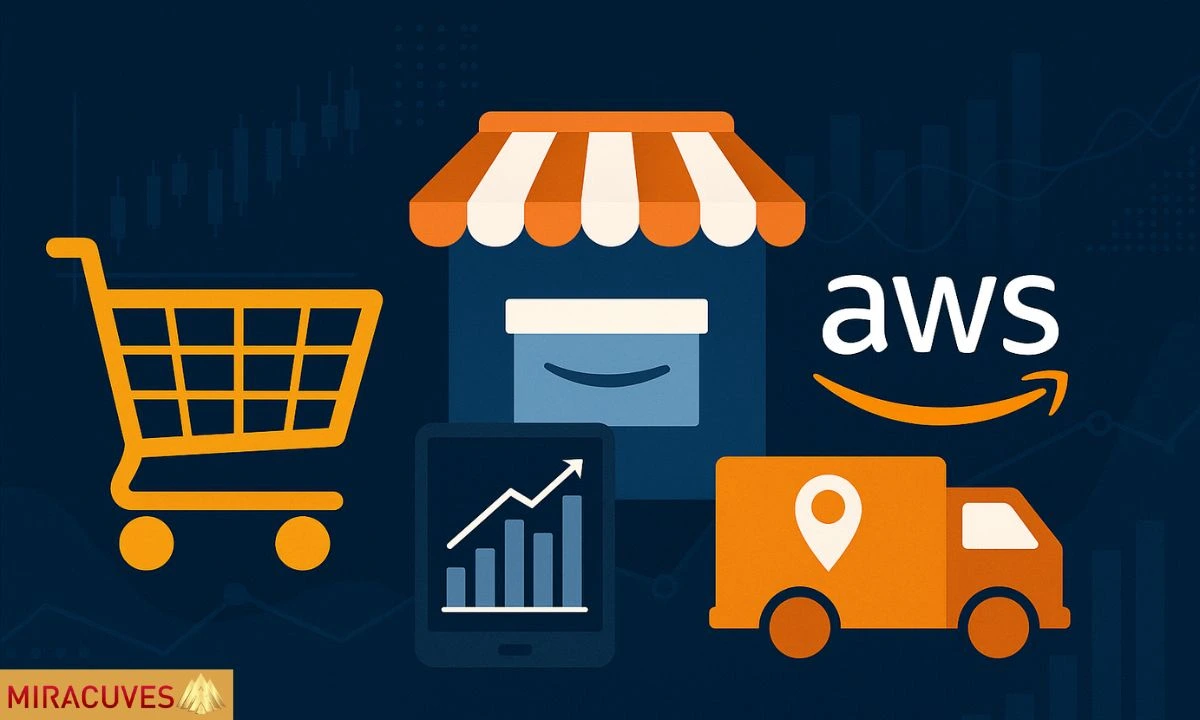Amazon isn’t just an online store — it’s an ecosystem. From one-click orders to AWS cloud services, Amazon has turned convenience into a revenue machine. What started as a digital bookstore now powers global e-commerce, logistics, cloud computing, media, and more.
But how does it really make money? What keeps its engine running across such a wide range of verticals?
In this blog, we’ll break down the business model of Amazon, explore how it drives revenue across multiple industries, and uncover insights startup founders can use if they’re building their own Amazon-like platform. Whether you’re planning an eCommerce clone or exploring marketplace monetization, this breakdown will give you the blueprint behind the behemoth.
What is Amazon & How It Works
At its core, Amazon is a multi-sided e-commerce marketplace — connecting millions of buyers and sellers globally. But it’s far more than just a shopping site.
Amazon operates as:
- A retail platform (selling its own inventory)
- A marketplace (enabling third-party sellers)
- A subscription service (via Prime)
- A cloud provider (via AWS)
- A media streaming hub (with Prime Video, Audible, and more)
What makes Amazon so powerful is its vertical integration — it doesn’t just sell products; it also manages the warehousing, logistics, payments, and cloud infrastructure that power those sales.
User flow is seamless:
- Customers browse and purchase on the Amazon app or site
- Products are shipped via Amazon’s own fulfillment network (FBA)
- Sellers get paid, and Amazon takes its cut
- Meanwhile, AWS powers everything behind the scenes — not just for Amazon, but for major global platforms
Think of Amazon as the infrastructure of commerce — owning both the mall and the electricity that powers it.
Who Uses Amazon (Target Users & Audience)
Amazon’s user base is massive — but more importantly, it’s segmented across multiple use cases.
For Consumers:
- Everyday shoppers looking for fast delivery, competitive pricing, and convenience
- Prime members who value exclusive access to deals, faster shipping, and streaming content
- Kindle users and audiobook listeners hooked into Amazon’s content ecosystem
For Sellers:
- Small businesses using Amazon as their storefront
- DTC brands leveraging Fulfillment by Amazon (FBA) to reach a global audience
- Private-label resellers creating niche products under Amazon’s vast umbrella
For Enterprises:
- Startups, fintech companies, SaaS brands, and even government bodies use AWS to run everything from hosting to machine learning
For Media Consumers:
- Users streaming Prime Video or listening to Audible content, even without buying physical products
Amazon doesn’t just sell to “users” — it creates micro-ecosystems tailored to each segment, each generating its own revenue stream.
Core Features that Power Amazon’s Business Model
Amazon’s business isn’t just about selling — it’s about scaling everything. Each feature is designed to remove friction, build trust, and increase lifetime value.
Here are the features that make Amazon more than just a marketplace:
Key Revenue-Driving Features
- One-Click Ordering
Eliminates cart friction and increases impulse buys — a game-changer in conversion psychology. - Fulfillment by Amazon (FBA)
Third-party sellers can store products in Amazon’s warehouses, and Amazon handles packing, shipping, and customer service — at a fee. - Amazon Prime
Membership that bundles free shipping, Prime Video, exclusive deals — and creates lock-in through benefits stacking. - Personalized Recommendations
AI-driven product suggestions that increase AOV (Average Order Value) and repeat purchases. - AWS Infrastructure
While invisible to the average shopper, AWS powers apps, websites, and enterprises — and accounts for massive profit margins. - Third-Party Marketplace Tools
Seller dashboards, ad platforms, analytics — all monetized directly within the Amazon ecosystem. - Amazon Pay & Subscriptions
Built-in payment gateway and recurring billing APIs allow frictionless transactions for both products and digital services.
For founders, the takeaway is simple: every core feature is also a revenue opportunity.
Revenue Streams – How Amazon Makes Money
Amazon doesn’t rely on just one revenue source — it runs a multi-engine monetization system that earns from every angle: customers, sellers, partners, and even competitors.
Here’s a breakdown of Amazon’s major revenue streams in 2025:
Amazon Revenue Streams
| Revenue Stream | How It Works |
|---|---|
| Online Retail Sales | Products sold directly by Amazon (inventory model) |
| Third-Party Marketplace Fees | Commissions on sales by external sellers + monthly seller subscriptions |
| Fulfillment Services (FBA) | Charges for storage, packing, and shipping via Amazon’s logistics network |
| Amazon Prime Membership | Annual/monthly fees for premium benefits like free delivery and Prime Video |
| Amazon Web Services (AWS) | Cloud services sold to startups, enterprises, and public sector clients |
| Advertising Revenue | Sponsored product placements, video ads, and search result promotions |
| Digital Products & Subscriptions | Kindle, Audible, Prime Video rentals, and in-app purchases |
| Amazon Pay (Fintech Arm) | Payment gateway services with processing fees and transaction margins |
| Licensing & Partnerships | Content licensing (Prime), tech collaborations, Alexa integrations |
Amazon’s model is designed for layered monetization — it earns when you shop, when you sell, when you stream, and even when you build your startup on AWS.
Cost Structure – What It Takes to Operate Amazon at Scale
Running Amazon isn’t cheap — but it’s efficient. Its cost structure is vast, distributed, and optimized for scale. For anyone building an Amazon-like app, understanding these costs is key to modeling ROI.
Major Cost Components
- Logistics & Fulfillment Infrastructure
- Warehousing, packaging, shipping, reverse logistics
- High fixed costs, but with economies of scale through FBA
- Technology & Platform Development
- AWS, recommendation engines, mobile/web UX, payment systems
- This is Amazon’s tech backbone — and a big upfront investment for clones
- Content Acquisition (for Prime Video, Kindle)
- Licensing movies, series, audiobooks, and eBooks
- A huge cost for media arms, less relevant for pure eCommerce clones
- Customer Service Operations
- Chat, call, and support center infrastructure
- Automated tools + human agents = hybrid support model
- Marketing & Advertising
- Paid search, brand ads, influencer campaigns, referral incentives
- Amazon invests heavily to stay top-of-mind
- R&D and Innovation
- Smart tech (Alexa), drone delivery R&D, AI personalization
- Long-term bets that differentiate Amazon beyond just retail
For founders cloning Amazon’s model, the biggest cost drivers are usually: logistics, tech stack, and customer acquisition. But smart outsourcing and MVP scoping can drastically reduce these during early stages.
Recent Innovations in Amazon’s Business Model (2024–2025)
Amazon’s success lies in its ability to evolve — and 2025 is no different. While the core engine remains the same, Amazon is layering on new monetization levers, smarter tech, and wider reach.
Key Shifts You Should Know:
- Ad Revenue Surge with AI Targeting
- Amazon Ads now uses generative AI to create auto-optimized campaigns for sellers
- Sponsored results and product videos are a major profit center
- Global Expansion into Tier-2 Markets
- Focus on regions like Southeast Asia, MENA, and LATAM
- Local partnerships and mobile-first shopping UX prioritized
- AI-Driven Fulfillment Optimization
- Predictive inventory stocking, drone-assisted last-mile delivery pilots
- Major logistics cost savings + faster delivery SLAs
- Amazon Prime Goes Modular
- Users can now select Prime Video-only, Prime Shopping-only, or bundle tiers
- Flexible pricing = more subscribers, less churn
- Voice Commerce with Alexa Upgrades
- AI-enhanced Alexa now handles order tracking, reordering, and cross-sells
- Building a strong “invisible commerce” channel
- Sustainability & Carbon-Neutral Initiatives
- Electric vehicle fleets, recyclable packaging, and eco-brand badges
- Becoming a key factor in customer preference (especially Gen Z)
These updates show that Amazon’s model isn’t just scalable — it’s adaptive. And that’s the real blueprint for founders: build once, evolve forever.
Takeaways for Founders Who Want to Clone Amazon’s Business Model
If you’re planning to build an Amazon-style platform, don’t just copy the surface. The real value lies in understanding the systems behind the scale — and replicating them intelligently.
Here’s what you can learn (and leverage):
1. Start Narrow, Scale Horizontally
- Amazon started with books, not “everything.”
- Pick a niche or underserved category (e.g., local groceries, pet products), then expand.
2. Let Sellers Do the Heavy Lifting
- Use a third-party marketplace model.
- Monetize by charging commissions, ads, and fulfillment fees — not just direct sales.
3. Build Smart Logistics, Not Just Pretty UI
- Fast delivery is more important than flashy design.
- Integrate with hyperlocal delivery partners, automate tracking, optimize warehousing.
4. Bundle Services to Maximize Retention
- Think beyond eCommerce — can you offer loyalty rewards, subscriptions, or financing tools?
- “Prime-like” benefits can boost customer stickiness.
5. Data Is the Real Asset
- Every search, click, and cart action is monetizable.
- Use data to improve personalization, recommendations, and upsells — just like Amazon.
The goal isn’t to become the next Amazon overnight — it’s to use their model as a playbook, then adapt it to your niche, market, and growth phase.
Conclusion
Amazon didn’t just build an eCommerce website — it built an empire powered by smart logistics, layered revenue models, and relentless innovation. Its business model continues to evolve, tapping into cloud infrastructure, digital subscriptions, and even AI-driven advertising.
For startup founders and entrepreneurs, Amazon’s journey isn’t just impressive — it’s replicable (with the right team and tech).
Want to Build Your Own Amazon-Style App?
At Miracuves, we don’t just build apps — we help you bring proven business models like Amazon’s to life.
✅ Pre-built clone frameworks
✅ Fast go-to-market timelines
✅ Scalable, monetizable architecture
✅ Custom features tailored to your niche
👉 Contact us now to build your Amazon-style eCommerce platform.
FAQs
How does Amazon make money in 2025?
Amazon earns revenue through multiple streams: online retail sales, commissions from third-party sellers, Prime memberships, AWS cloud services, advertising, and digital subscriptions. Its ability to monetize both users and infrastructure makes its model extremely powerful.
Is Amazon profitable from eCommerce alone?
Surprisingly, no. While retail brings in high volume, the real profits come from AWS (cloud) and advertising. Retail runs on thin margins, but services like AWS deliver high-margin, recurring revenue.
What is Fulfillment by Amazon (FBA)?
FBA is Amazon’s logistics service for third-party sellers. Sellers send inventory to Amazon’s warehouses, and Amazon handles storage, packaging, shipping, and customer support — in exchange for a fee.
Can I build an Amazon-like app for my niche market?
Yes. Many startups are launching niche marketplaces using Amazon’s model as a blueprint — especially in local groceries, books, fashion, and home services. With the right tech and monetization strategy, it’s a scalable path.
Is it legal to build an Amazon clone?
Building an “Amazon-style” app is legal as long as you’re not copying branding, trademarks, or copyrighted content. You’re replicating the business model, not the brand. Miracuves specializes in building such legal, scalable clone platforms.








